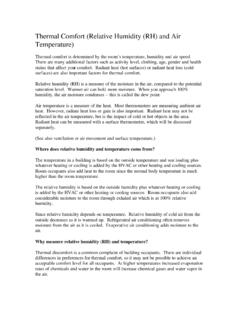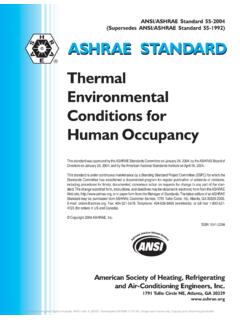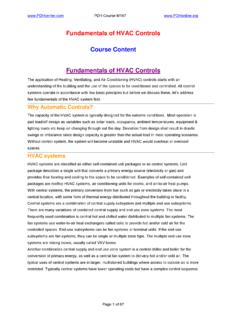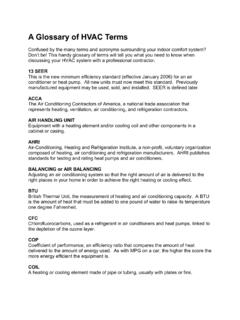Transcription of FACTORS AFFECTING RESEARCH RESULTS - AskJPC
1 1 FACTORS AFFECTING RESEARCH RESULTSWhat is the single largest factor AFFECTING RESEARCH outcomes? Researcher bias: How clean/pure should the glassware or reagents be? What is (or is not) important to the RESEARCH What is (or is not) important to the RESEARCH outcomes? 1stquestion researchers should ask: What am I doing that may impact the laboratory also sharing this holding room, procedure room, or equipment\? FACTORS AFFECTING RESEARCHINTRINSIIC: Inherent to the animal INTRINSIIC: Inherent to the animal Genetics, age, sex, health, nutritional status, immune status, circadian rhythms, endocrine factors2 INTRINSIC FACTORS AFFECTING RESEARCHG enetics OUTBRED ANIMALS: Problems occur when: Colony decreases in size insufficient to maintain heterogeneity Management techniques do not ensure genetic variability INBRED ANIMALS: Problems occur when there are.
2 Incomplete inbreedings Mismatings Inadvertent outcrossings with other strains Spontaneous mutations Chromosomal aberrations Residual heterozygosityTAKE HOME MESSAGE: GENETIC INTEGRITY IS NOT GUARANTEEDBY ITS NOMENCLATURE!INTRINSIC FACTORS AFFECTING RESEARCH Genetics Spontaneously hypertensive (SHR) and Wistar Kyoto (WKY) rats: Genetically disparate, while from the same parental Wistar stock. WKY, used as controls, were discovered to share only approximately 50% of their DNA fingerprint bands in common with SHR. Heterogeneity between Dahl salt sensitive rats (SS/Jr) and Dahl salt resistant rats (SR/Jr) is small (80% common DNA).
3 Variable metabolism due to qualitative and quantitative enzyme differences between species and strains: Cytochrome P450 concentration and competing isoenzymes Defective/absent enzymes or presence of unique enzymesTAKE HOME MESSAGE: SELECT THE STRAIN CAREFULY! Factor in rodent carcinogenicity studies. Neonates have immature body systems compared to FACTORS AFFECTING RESEARCH AgeNeonates have immature body systems compared to adults. Older animals may develop deficiencies as previously normally functioning systems fail. On occasion the response may be strain related!
4 TAKE HOME MESSAGE: MATCH THE AGE TO THE NEED!3 Marked differences in pharmacologic and toxicologicresponses to xenobiotics has been demonstrated between male and female FACTORS AFFECTING RESEARCH Gender Sex related differences in DMBA induced mammary tumors: Wistar Furth rats: 100% in females; 19% in males. Copenhagen rats: No difference between males and females Immunologic dysfunction, including hypersensitivity and allergy, autoimmunity and immunodeficiency may influence experimental FACTORS AFFECTING RESEARCH Immune Status Agents that alter immune function: Age Nutirtional status Chemicals Drugs Food additives Metals Microbes Resistance to infectious agents may be dependent on the type of immune response that the host generates: CBA/J mice are highly resistant to L.
5 Major as they develop a cellmediated response vs the humoralINTRINSIC FACTORS AFFECTING RESEARCH Immune Statusdevelop a cell mediated response, vs. the humoralresponse of the non resistant BALB/c 100% incidence of leukemia in response to murineleukemia virus by mice (humoral) vs. resistance by mice (cellular)4 Nutritional status is dependent on: Type of feed provided Method and amount of feedingINTRINSIC FACTORS AFFECTING RESEARCH Immune Status Appetite Age Various dietary conditions such as mineral, vitamin and protein deficiencies, lipid composition, and the composition of the diet alter the biotransformation of HOME MESSAGE: KNOW WHAT YOU ARE FEEEDING!
6 Many behavioral, biochemical and physiologic parameters (daily, rhythmic, minima and maxima) occur at specific times: Blood counts and coagulation times [CD 3 molecules] on T cell surfaceINTRINSIC FACTORS AFFECTING RESEARCH Circadian Rhythms[CD3 molecules] on T cell surface T cell response to mitogens Plasma steroid Body temperature Sensitivity to audiogenic seizure induction Drug metabolism and toxicity Susceptibility to neoplasia DNA, protein synthesis TAKE HOME MESSAGE: BE CONSISTENT WITH DATA COLLECTION! Sex hormones are important determinants of cytochromeP450 enzyme diit d t fl t i th i INTRINSIC FACTORS AFFECTING RESEARCH Endocrine FACTORS Testosterone administered to female rats increases their ability to biotransform xenobiotics Castrating male rats decreases the ability to HOME MESSAGE: SEX IS IMPORTANT!
7 CHOOSE Gonadectomy, hypophysectomy and adrenalectomy will alter hormonal levels Neonatal gonadectomyof CE and DBA strains of mice INTRINSIC FACTORS AFFECTING RESEARCH Endocrine Factorsgyleads to high incidence of estrogen secreting adrenal tumors Postulated that hypersecretion of trophic pituitary hormones in gonadectomized ferrets may result in stimulation of the adrenal gland, producing adrenal gland tumorsTAKE HOME MESSAGE: SEX IS IMPORTANT! CHOOSE WISELY. Prolactin secreting pituitary adenomas may develop in nulliparous rabbits because of exposure of pituitary acidophils to high concentrations of plasma estrogens secreted by ovarian FACTORS AFFECTING RESEARCH Endocrine Factorsy Prolactin secreting tumors also develop in rats following prolonged administration of natural or synthetic HOME MESSAGE: SEX IS IMPORTANT!
8 CHOOSE AFFECTING RESEARCHEXTRINSIC: External to the animalEXTRINSIC: External to the animalPhysical FACTORS , chemical FACTORS , microbial agents, stressors 6 PHYSICAL CHEMICAL AirEXTRINSIC FACTORS AFFECTING RESEARCH Water Diet Drugs MICROBIAL AGENTS STRESSORS ENVIRONMENTAL Macro vs. Micro Environment Cage DesignEXTRINSIC FACTORS AFFECTING RESEARCH Physical FACTORS Caging Accessories Temperature humidity Ventilation Illumination Noise MICROENVIRONMENT The physical environment immediately surrounding the ilEXTRINSIC FACTORS AFFECTING RESEARCH Physical Factorsanimal.
9 The primary enclosure MACROENVIRONMENT The physical environment of the room , cubical, etc. The secondary enclosure7 Amount of air, light and sound the animal receives. EXTRINSIC FACTORS AFFECTING RESEARCH Cage Design Amount of heat, humidity and gaseous waste dissipated into the HOME MESSAGE: RECORD CAGE DESIGN AS A VARIABLE! Solid bottom caging for rodents Behavioral EXTRINSIC FACTORS AFFECTING RESEARCH Cage Design Behavioral characteristics Recovery cages Mouse urologic syndrome Randomization of cage locationEXTRINSIC FACTORS AFFECTING RESEARCH Cage Design Rack placement Cage placement on the rack may be important!
10 Rack vendors work hard to make all slots equal, but .. Rack location may impact study HOME MESSAGE: ROTATE CAGE PLACEMENT ON RACKS!8 EXTRINSIC FACTORS AFFECTING RESEARCH Cage Design a few facts .. 68 F (20 C) air moving at 60 liner feet per minute has a cooling effect of 45 F (7 C). ACH has a wash out effect upon pheromones Study: Effect of IVC air flow on rats: 60 ACH did not impair the reproductive performance Higher air flow increased the survivability of litters and .. those litters were more uniform in size and viability over the control in an open topped cage.




